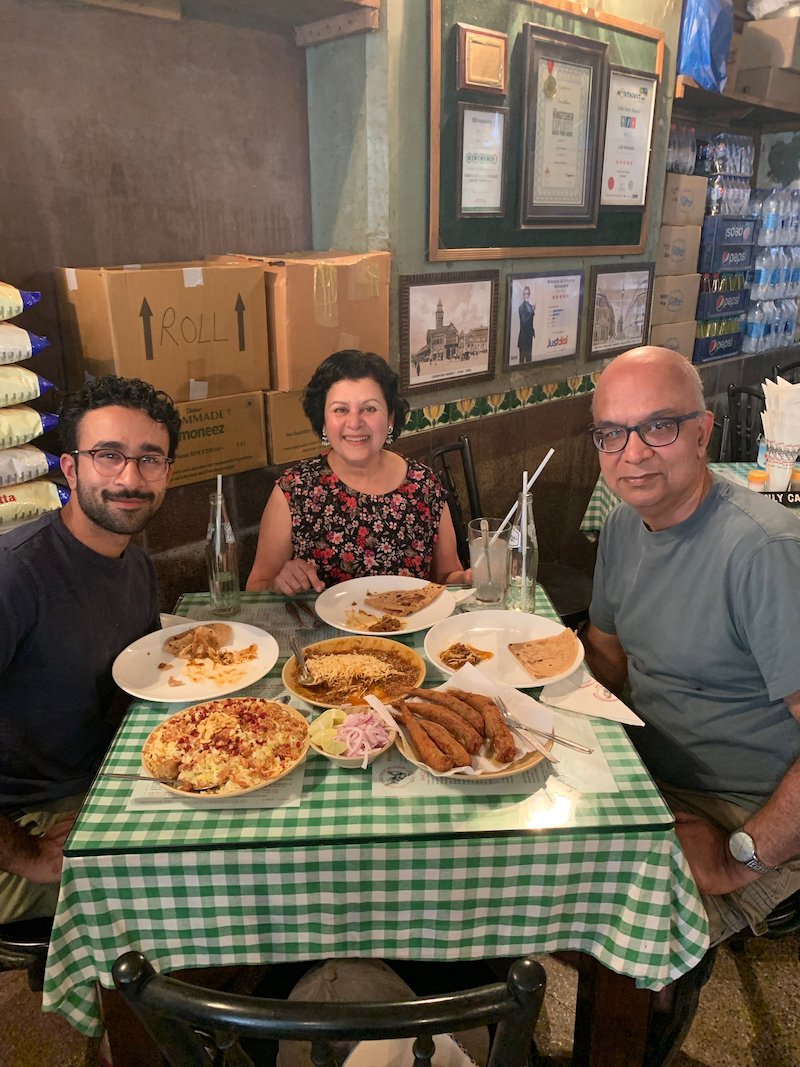Mutton Berry Pulao In Mumbai, India
You get to see a city with fresh eyes only twice in your life: once when you visit it for the first time, and next when you visit it with your children. We recently got an entirely new view of Mumbai when we travelled there with our son.
What with the havoc caused by the pandemic, it had been far too long since we last had a family gathering in India. So when our extended family announced they were planning a reunion in Mumbai, it seemed too good an occasion to miss. And when our son Varun, who now lives in New York, declared that he wanted to come as well, that definitely decided it. We were all off to Mumbai!
It has been years since any of us lived in Mumbai, then Bombay, for any length of time. Varun got a summer job in Mumbai for a few months when he was a university student and fell in love with this vibrant, bustling metropolis. We all had fond, but very different memories of the city, and resolved that we were going to share our versions of Mumbai with each other!
Any tour of Mumbai has to start at the Gateway of India, the massive stone archway overlooking the sea that was built by the British as a symbolic entrance to the country, where princes and viceroys were received. It is still the most recognizable landmark in Mumbai, and opens onto a plaza facing the Taj Mahal Palace Hotel, perhaps the most famous hotel in India.
Next on our list was a walk along Marine Drive, the sweeping promenade that runs along the western periphery of south Mumbai. It is one of the rare places in the city where you can stroll without having to fight crowds, and is a popular destination for tourists. Visitors stand on the embankment snapping selfies, the skyscrapers of the city providing the perfect backdrop. This is also a favourite refuge for young couples seeking a moment of privacy in the big city.
Another Bombay landmark, Crawford Market, is housed in an old Victorian building, but there is nothing stately about the interior. Stalls piled high with fruits, vegetables, spices, nuts, flowers and clothing line the interior, jostling for space with throngs of workers, shoppers, tourists and even stray cats!
I remember going to Crawford market with my dad when I was young, and buying fresh vegetables which my mother would turn into delicious dinners. This is where we would find exotic produce like mushrooms and the sweetest Alphonso mangoes. Walking through the market with Varun brought back all those delicious childhood memories!
Varun’s choice for where to go next was Mohammed Ali Road, one of the the best known areas in Mumbai for street food. It is famous for the food stalls that spring up during the month of Ramzan, where Muslims who have been fasting all day come after sundown to eat biryani and kebabs. The aromas wafting from the different food stalls enticed us to stop and sample some of the wares. One of our favourites were the samosas that were stuffed, folded and fried right in front of us as we waited - they were crisp, hot and delicious!
The lanes leading off Mohammed Ali Road are packed with vendors of all types, selling food, fresh fruit, vegetables and flowers. The number and variety of things for sale is absolutely mind-boggling - you can spend days wandering these streets and never be able to see it all. There are wholesalers of building materials, hardware, machine parts, electronics, luggage and clothing, with entire lanes devoted to just one product. My favourite was jewellers lane, I could have happily spent a lot more time there!
Exhausted by our wanderings, it was time for lunch. We headed off to another Mumbai landmark - Britannia & Co, which is is one of the few remaining Irani cafés in the city. A century ago there were hundreds, run by immigrants from Iran. They offered a limited menu: buns stuffed with minced meat; mutton samosas; berry pulao; and lentils with chicken were favourites. However, they proved wildly popular since they were cheap and welcomed all customers, irrespective of gender, race or religion. Irani cafés quickly became places for young people to congregate, and café owners struggled to restrain their often unruly clientele. Their lists of house rules, prominently posted on café walls, became famous and inspired Bombay poet Nissim Ezekiel to compose an entire poem from them:
IRANI RESTAURANT INSTRUCTIONS
Please
Do not spit
Do not sit more
Pay promptly, time is valuable
Do not write letter
without order refreshment
Do not comb,
hair is spoiling floor
Do not make mischiefs in cabin
our waiter is reporting
Come again
All are welcome whatever cast
If not satisfied tell us
otherwise tell others
GOD IS GREAT
While most Irani cafés have now vanished, victims of changing tastes and soaring real estate prices, Britannia & Co proudly keeps the tradition alive. Founded in 1923, it has just celebrated its centenary and looks as if it has not renovated its interior since it was built. Pictures of the Queen and the royal family look down from the walls, the only concession to Indian independence being that they now share space with Mahatma Gandhi. The list of rules posted are just as abrasive as you would expect.
The menu lists all the classics, and we tried a good few of them - Salli Keema (spicy ground chicken topped with deep fried potato sticks, Bombay Duck ( no ducks involved here, just deep fried dried fish), flaky parathas, Raspberry Soda and their justly famous Caramel Custard. And when we had finished and were ready to pay we met Julio, the beloved café mascot, who spends all day reclining on the cash counter, keeping an eye on cusomers through sleepy eyes.
Cafe Britannia regularly has long line ups of eager, hungry patrons waiting to dig into their favourite Parsi dishes. One legendary dish they all come here to eat is the Mutton Berry Pulao. Created over 30 years ago by owner Boman Kohinoor’s wife Bachan, this pulao quickly became a bestseller on the restaurant’s menu, the recipe still a closely held secret. It is the perfect fusion of Indian and Persian cuisines, with a spicy lamb curry layered beneath saffron tinted rice, topped with fried onions, nuts and barberries which add a pop of colour and a hit of tartness to the pulao. This was our favourite too and my son Varun has been after me to crack the secret of the recipe ever since!
The original recipe calls for the pulao to be studded with spicy lamb kebab meatballs, which definitely add a unique touch to the dish. I’ve skipped them in my recipe to keep it simple, but if you want to add them, you can make your own. Nestle them in the rice just before you serve the pulao .
The list of ingredients and steps in the making of this pulao can seem a bit daunting. The good news is that you can prepare a lot of the components ahead of time. The lamb curry can be made up to three days before and actually tastes better as it sits in the refrigerator. The sauteed onions, nuts and barberry topping can also be made earlier, simplifying your life on the actual day of cooking. Depending on how many people you are planning to serve, this recipe also produces very satisfying leftovers for another day! Serve it with Chana Masala for a satisfying meal.
Mutton Berry Pulao
4 tbsp oil, divided
8 each, whole spices, divided: cardamom, cloves
4 each, whole spices, divided: star anise, mace florets
2 pieces of cinnamon stick, 2 inches each, divided
1 medium onion, chopped
2 cloves garlic, chopped
1 inch piece ginger, chopped or grated
6-7 whole canned plum tomatoes
Salt to taste
1 tsp each, ground spices: turmeric, coriander, cumin, fennel, dried fenugreek leaves, garam masala
1/2 tsp cayenne pepper or chilli powder
1 lb boneless pieces of lamb or goat
1 lrg potato, peeled and cubed into large chunks
2 tbsp each, finely chopped: fresh coriander and mint
1 1/2 cups Basmati rice
1 lrg onion, thinly sliced
1/2 cup dried barberries
2 tbsp each: slivered almonds, pistachios or cashews
4 tbsp melted butter, divided
2 boiled eggs, peeled and halved
1/4 tsp saffron soaked in 2 tbsp warm water
1 tsp rose essence
Prepare the lamb curry:
Warm 2 tbsp oil in deep heavy saucepan set over medium heat.
Add 4 each of the cardamom and cloves, 2 each of the star anise and mace florets and 1 of the cinnamon sticks. Sizzle for a min, then add onions, garlic and ginger.
Saute for about 5-7 min, until they are softened and lightly browned. Add tomatoes.
Cook tomatoes until they soften into the sauce and become mushy, about 5-7 min.
Add all the ground spices and salt. Stir to mix.
Add lamb and coat well with the sauce. Cover and cook on low heat for an hour, then add cubed potatoes. Cook for another hour until lamb is very tender and sauce is very thick. Stir occasionally to prevent burning.
Fold in fresh coriander and mint.
While the lamb is cooking, prepare the rice:
Bring 6 cups of water and remaining whole cardamom, cloves, cinnamon, star anise and mace to boil in large saucepan. Add rice and salt to taste, stir gently to mix. Cook for 8 minutes until rice is half done and still firm. Drain rice, keeping the spices in it and spread it on a tray to cool.
Warm remaining 2 tbsp oil in a skillet over medium high heat. Add sliced onions and saute them until golden, about 10 min.
Add barberries, almonds and pistachios or cashews to skillet, saute 1 min.
Assemble the pulao:
In a heavy, wide bottomed saucepan, melt 2 tbsp butter over medium low heat.
Spread the lamb and all the sauce on the bottom of pan.
Top with partially cooked rice, spreading it evenly over the lamb.
Spread the fried onions, nuts and barberries over top.
Nestle the halved boiled eggs in the rice.
Combine saffron water with rose essence, drizzle it over top of the pulao.
Drizzle remaining 2 tbsp melted butter over top.
Cover and then reduce heat to very low and cook for 45 min without uncovering or stirring the rice in between. Serve right away.
Note: The whole spices in this dish are not meant to be eaten.
Serves four - six
















